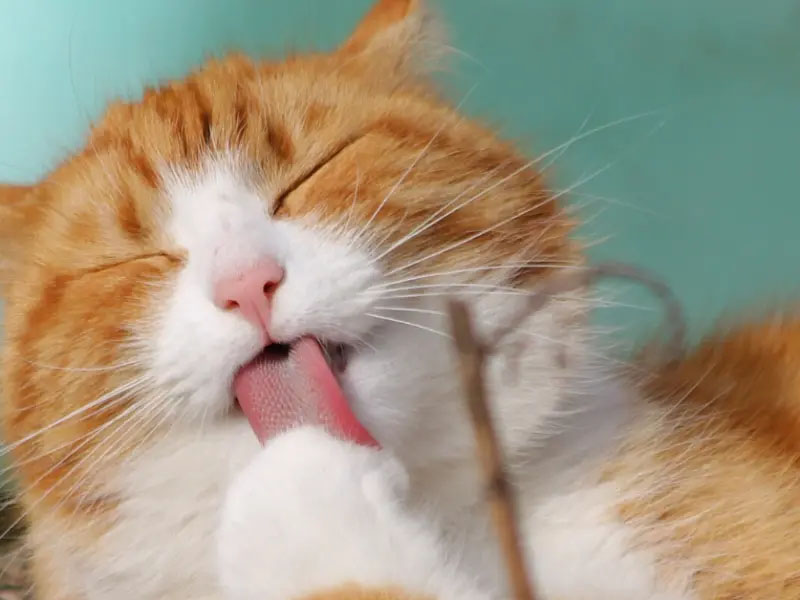
The Best Cat Hairball Remedy: 12 Solutions That Really Work
This post may include affiliate links. Please read my disclosure policy.
Cat hairballs—if you’ve ever lived with a cat, chances are that at one time or another, you’ve come across (or even stepped on) one of these gooey tubular masses of grossness.
Needless to say, we’d much rather spend our time cuddling with our cats than cleaning their hairballs off of our floors or feet.
Here are 12 tried and proven cat hairball remedies you can try at home.
12 Simple Remedies to Prevent Hairballs at Home
1. Brushing
Of course, one of the best hairball remedies is to stop them in the first place.
Regular brushing is a natural cat hairball remedy since it removes much of the excess fur that would normally be swallowed and regurgitated, reducing hairball formation. This is especially true for most long-haired cats.
It also provides a special opportunity for some bonding time with our kitties.
While some cats just love being brushed, others may not be quite so enthusiastic. Introducing grooming time gradually may help them adjust with as little pain (for cat or cat parent!) as possible.
Start with one or two strokes with a grooming glove from HandsOn® Gloves and follow up with special treats so your cat associates this time with something positive.
- Gentle bristles allow for effective grooming without uncomfortable friction
- Can handle short, medium, long, and coarse fur
- Tough enough to withstand baths, playful nibbles, and lots of love!
- The scrubbing nodules work to stimulate circulation and distribute natural oils, promoting a healthy skin and coat for your pet
Another paw-some tool I’ve dug up for kitty grooming is the Furminator. It’s small enough to fit in the palm of your hand, and it’s a great way to gently remove excess fur and prevent hairballs in cats.
You can gradually increase the time spent brushing as your kitty learns to tolerate, and hopefully enjoy, this quality time spent together.
- Stainless steel de-shedding edge reaches through topcoat to safely and easily remove loose hair and undercoat without damaging topcoat or cutting skin.
- Fur ejector button easily releases hair
- Curved edge glides over skin, preventing digging in at edges
- Ergonomic handle designed for comfortable, easy grooming.
Brushing doesn’t have to be a long, drawn-out process. Just a few minutes each day is usually enough for long-haired cats, and short-haired cats may only need to be brushed a few times each week.
2. Bathing
After you’ve brushed your cat, take hair removal to the next level by giving your cat a bath.
Bathing your kitty can be a great hairball remedy since you’re removing the loose fur for her. While most cats prefer to groom themselves, if your cat is prone to hairballs, you may have to take matters into your own hands. Remember to use a shampoo that is safe for cats, as they are very sensitive to over-drying and scented ingredients; do not use dish soap or human shampoo.
3. Wipes
After brushing your cat or after your cat is dried off from their bath, take a pet wipe and gently pat your cat with it, collecting any loose fur. This further helps prevent hairballs in cats.
Make sure to use a wipe that’s safe for cats, like this cat wipe. Or you can simply wet a paper towel and use it to collect the loose hair from your cat’s coat.
4. Pumpkin Powder
Using pumpkin powder is another great hairball remedy for cats. It contains lots of fiber that helps move the hairball through your cat’s digestive tract and most cats love the taste.
Sprinkle a little pumpkin powder on their food to provide fiber and nutritional value. Remember to always have fresh water available when you add dry ingredients to your kitty’s diet.
5. Carrots
Carrots are another good source of fiber and can help move a hairball along and maintain a healthy digestive tract. They’re generally considered safe for cats as long as they’re cooked until soft.
You should never give your cat raw carrots as it can lead to further digestive issues. Also, carrots can be high in sugar. A small amount is all that is needed, and overfeeding carrots can lead to weight gain.
Pin Me!
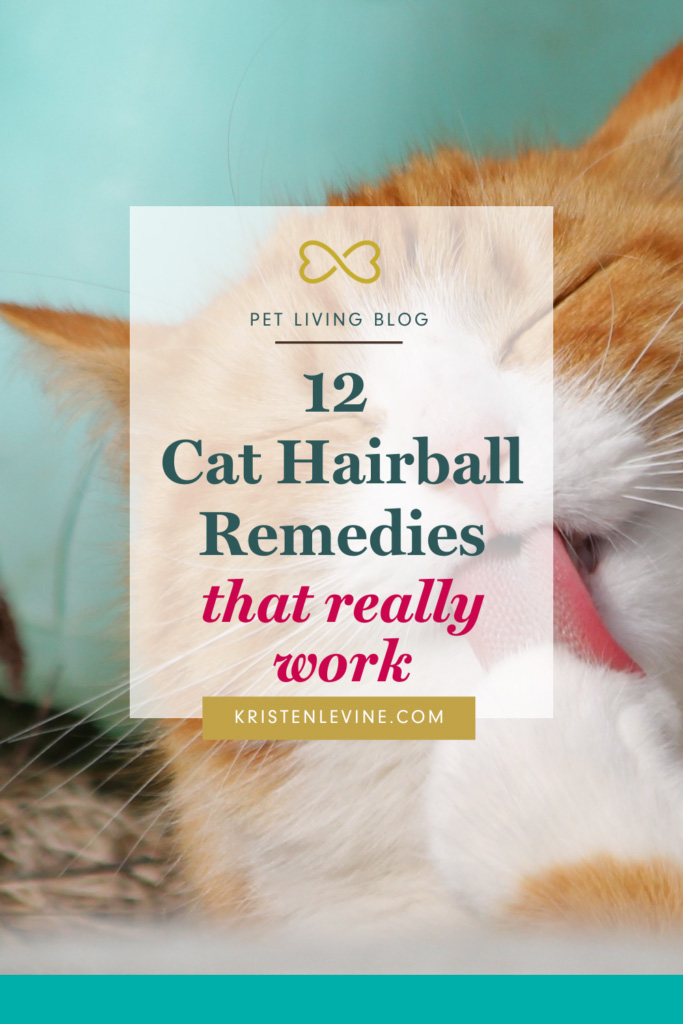
6. Hairball Control Treats and Food
Temptations Hairball Control Treats
Treating hairballs in cats can also be as simple as a delicious treat! I love these hairball control treats not only because they help eliminate hairballs but also help your kitty maintain good dental hygiene You can use them as a low-calorie treat or as a meal topper.
The chicken flavor tastes good to most cats, so you won’t have to convince them to take their cat hairball “medicine.”
Nulo Freestyle Hairball Management Food
One reader from Facebook commented, “I’ve not had to use anything extra since switching them all to Nulo Hairball Management.” We love to hear about things that work for real pet parents!
This food promotes hairball control, as it contains miscanthus grass, which is loaded with fiber to help your cat pass hairballs as well as essential fatty acids to keep your cat’s digestive tract lubricated.
- Turkey and cod recipe made for hairball management with natural fibers from miscanthus grass to promote your cat's digestion and support their coat.
- Formulated with Vitamins E and C and Omega-3 and -6 fatty acids to support a healthy immune system and beautiful, shiny coat
- Made in the USA with no corn, wheat gluten, soy, artificial preservatives, colors, or flavoring.
Purina One Hairball Formula
Another reader swears by Purina One, saying, “I’ve used Purina One Hairball control dry mixed into their dry food. No hairballs for years.”
This formula is also loaded with fiber but is high in protein as well.
Whatever food or treats you decide to use should contain plenty of fiber to help your cat pass hairballs with ease. Check with your veterinarian for optimal feeding advice.
7. Tomlyn Hairball Remedy
This hairball “medicine” comes as a gel or soft chew. It contains Omega 3 fatty acids and lubricants designed to make your cat pass the hairball naturally and safely. Lubricants are one of the best ways to help your cat pass a hairball.
8. Olive Oil
Olive oil is one of the best natural cat hairball remedies. It acts as a natural lubricant, and a little goes a long way! A teaspoon over the course of a week is fine for most cats and will help them pass a hairball naturally.
9. Fish Oil
This might be your cat’s favorite hairball remedy! Small canned fish like sardines, as well as tuna, are usually packed in oil.
Give your cat a treat and add a little oil to your cat’s diet. The lubrication will assist your cat to pass the hairball into her litter box without discomfort.
10. Nutri-Vet Cat Hairball Support Paw Gel
This petroleum alternative is a mix of several vegetable oils and does a great job helping hairballs pass through the digestive tract. Simply add it to her food or put a small amount on her paw – she’ll enjoy the chicken flavor and you’ll enjoy not cleaning up as many hairballs.
11. Water
Something as simple as proper hydration can prevent hairballs in cats. If a cat’s diet isn’t providing enough moisture, her digestive tract is working harder than it should, which may make her hairball problem worse.
Turtle loved to drink from her Catit fountain!
Most cats actually prefer to drink moving, running water. That means even if your cat has constant access to a nice clean bowl of water, she may not be drinking enough. A water fountain is a perfect way to entice your kitty to drink more.
Our Pet Living cats love cat fountains, and they drink to their heart’s content!
A lot of kitties also enjoy very cold water in a glass bowl. There is something just so refreshing about a clear bowl, clean water, and a few ice cubes that may make your cat refresh herself more frequently. Simply drop a few ice cubes in the water once or twice a day and see how your furry feline responds.
Always aim to provide more than one source of water for your cat. That way, she doesn’t have to travel very far to get a quick drink. Some kitties prefer to drink water that is not near their food – so try a second drinking location to encourage water intake.
Drinking water is important, but your cat can also get hydration from her food. A cat who eats a diet composed of mainly dry cat food may not be getting the moisture that she needs.
Gradually introducing canned food with her kibble will increase her water intake. Thus, it will help her digestive tract to move all that hair and debris through instead of sending it back up where it came from.
12. Cat Grass
One Pet Living reader said, “We always have 5–10 cups of organic cat grass growing for them as well as brushing them daily.”
Cat grass is high in fiber, and it even looks pretty in your home!
We love this kind since it’s organic and comes in BPA-free containers.
How to Clean Up Your Cat’s Hairballs
When your cat coughs up a hairball on your floor, it leaves a mess! Because they contain biological material, they can stain and even smell bad, so it’s important to clean them up properly.
Here’s how to clean up cat hairballs the right way.
1. Scoop it up
Scoop up as much of the mess as you can with a paper towel and throw it in the trash.
2. Saturate the area with an enzyme cleaner
This step is critical. An enzyme cleaner like this one will eat the organic material in your cat’s hairball mess.
The surface, whether hard or soft, needs to be saturated with the cleaner so it can get in all the nooks and crannies and eat the odor and stain-causing bacteria.
But it only works if you follow this next step.
3. Allow time for the formula to work
After you’ve saturated the area, place a clean cloth on top and allow it to set overnight, at least for 12 hours. The biggest mistake we see when pet parents are cleaning up pee, poop, or vomit is to spray the area with cleaner and then wipe it away quickly.
Enzyme cleaners need time to dry in order to work. Allowing it to set overnight gives the enzymes time to eat the bacteria.
FAQs About Cat Hairballs
What Does a Cat Hairball Look Like?
A cat hairball, also known as a trichobezoar, often looks like an elongated cylindrical clump. Contrary to what their name suggests, they’re shaped like so because they’ve been formed in the cat’s esophagus. They’re composed of a dense mass of hair, and they may be a few inches long, with a slightly moist appearance and a color that generally matches your kitty’s fur.
Why Causes Hairballs in Cats?
Cats are meticulous groomers, and they use their tongues to get the job done. They much prefer bathing themselves over their humans bathing them.
Cat parents who have enjoyed the occasional affectionate tongue bath from their kitties will be familiar with the rough tongues our furry friends have.
According to Cornell University, the reason why their tongues are so rough is that they’re actually covered by tiny barbs, or papillae, which are perfect for removing dirt and other debris from their coats. They’re also perfect for grabbing excess fur and loose hair, which they then swallow.
Much of the time, this fur can pass through their digestive tract and come out the other end and into a litter box with no trouble.
However, when a large amount of fur becomes trapped in a kitty’s stomach, it gets regurgitated back up in the form of a hairball, or a cat furball.
How Do I Know if My Cat Has Hairballs?
The tell-tale cat hairball symptoms are all very familiar to most cat owners.
They often include coughing, gagging, retching, and hacking.
Most of the time, these sounds signal your cat is about to expel a hairball. So if you’re thinking, “My cat keeps throwing up, but she seems fine,” it could be that she’s just passing hairballs.
Are Hairballs Dangerous to Cats?
Yes, hairballs are potentially dangerous to cats. Long-haired cat breeds are at greater risk of developing hairballs than their short-haired counterparts.
There are some insidious signs that your cat is having difficulty with a hairball and may need medical attention.
While hairballs typically pass, it’s possible for them to become so large they lodge in your cat’s digestive tract and cause a potentially life-threatening blockage.
When Should I Worry about My Cat’s Hairballs?
If your cat has frequent hairballs or is retching without producing a hairball, has changes in digestion such as diarrhea, constipation, or lack of appetite, has become lethargic, or has a swollen or hard belly, it’s time to skip the home remedies and head straight to your veterinarian.
Also remember that a coughing cat appears similar to a kitty with a hairball. If you hear a lot of retching or coughing, but your cat never brings up a hairball, it may instead be a cough. Check with your veterinarian to be certain.
How Often Do Cats Have Hairballs?
Cats typically pass ingested hair through their digestive systems with minimal issues, leading to infrequent hairball occurrences—usually less than once a month for short-haired cats and possibly once a month for long-haired ones. You’ll need to call your vet if your cat has more than one hairball per week.
What if My Cat Is Trying to Cough Up a Hairball but She Can’t?
If your cat is struggling to hack up a hairball, keep a close eye on them. Unsuccessful efforts to dislodge a hairball could signal something more concerning. Watch for ongoing coughing, changes in appetite, or lethargy, and if you spot these, it’s time for a vet visit. The veterinarian might prescribe lubricant or laxative to help your kitty pass the hairball.
A chat with your veterinarian can lead to simple solutions like tweaking your cat’s diet, like increasing fiber intake, to prevent future issues. The goal is to manage hairballs without causing additional stress to your cat’s system, so vet-approved remedies are the way to go.
Is Vaseline Good for Hairballs?
Vaseline may help your cat pass a hairball through their digestive tract and is generally considered safe and nontoxic for cats. However, we don’t recommend it here at Pet Living since it’s a petroleum product, and there are many other more natural alternatives.
The Tail End
Cat hairballs are no picnic for you or your cat, but with regular grooming, proper hydration, a high-fiber diet, and sufficient lubrication, they can become nothing more than a minor annoyance.
Looking for more ways to keep your cat healthy? Download our free cat health checklist!









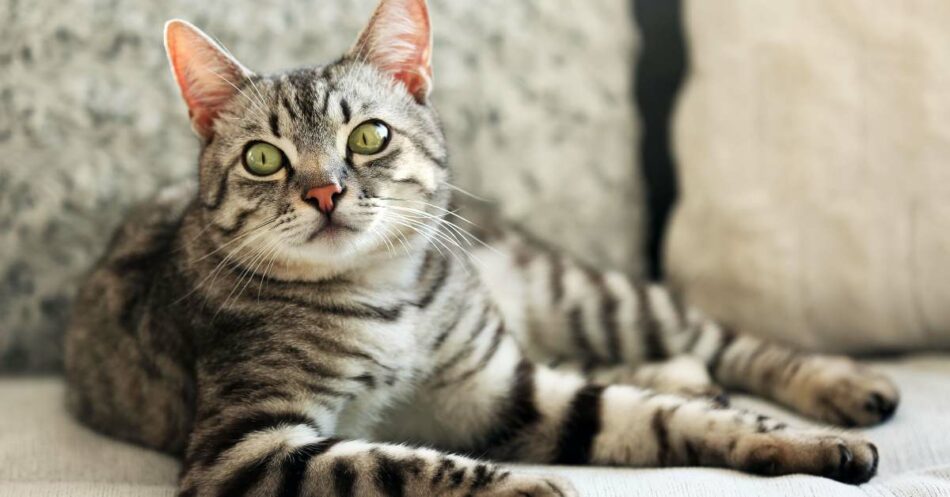
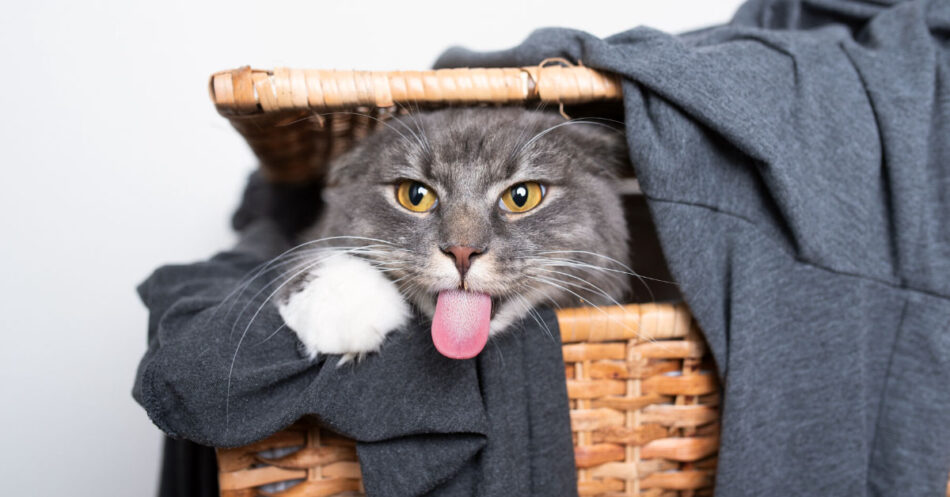
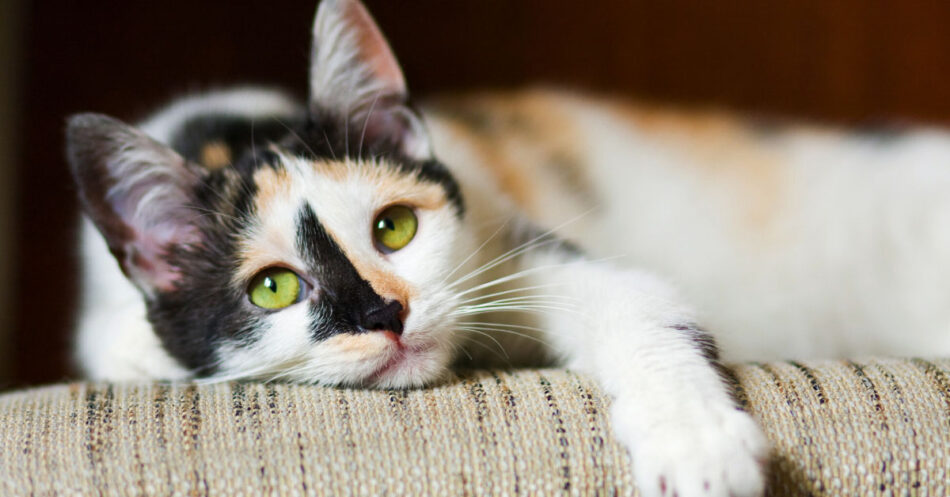
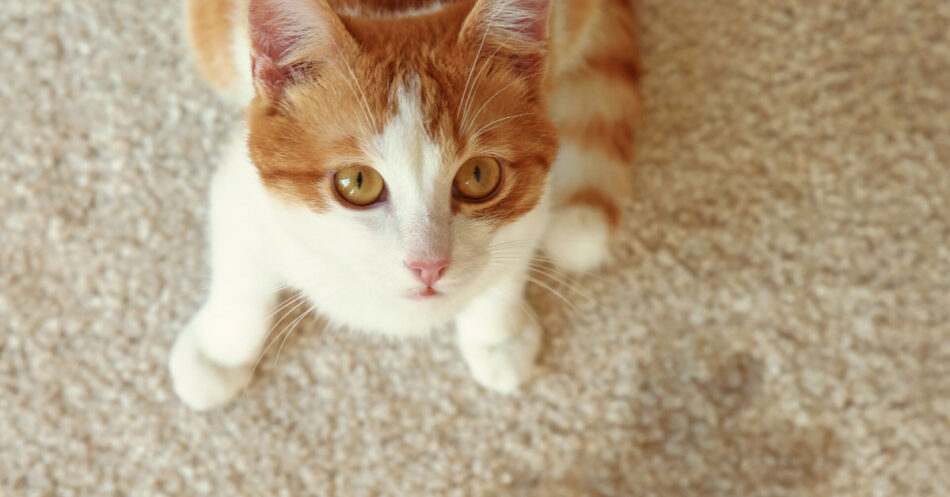
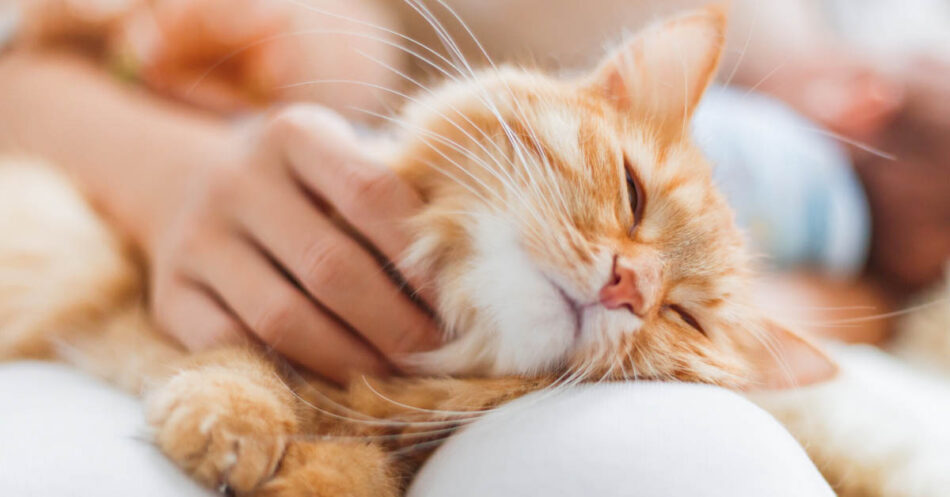
I leave a small bowl of Coconut Oil out for my cats to eat as they please, and they do. The oil is the good lubricant to cause the furballs to slide right on through if you get my drift. It also gives them a nice shiny coat. They all seem to like the taste just fine. Butter also does the same job if your cat likes it. And, yes, many pet stores sell tubes of a meat-flavored lubricant specifically meant for hairballs. They work well.
What a great idea Betty! Coconut oil! I have some in my pantry and I’m going to give it a try! Thanks for sharing:)
My cat ate some dried flowers and then started coughing and gagging for quite some time. I was worried about him. I didn’t have anything from the vet on hand so I put a tsp of softened butter on a plate and he lapped it down. Then I followed it with a drink of water from the sink which he loves. It did the job!
That is great that you were able to get those up!
It is definitely important to get those up if ingested, right away! If you run into that again and can’t get him to pass the flowers, you want to take him to the vet immediately.
Glad you found relief!
Kristen
I am so excited to try this! Thanks for the idea. I have some in my cupboard, too!
Let me know if you try it Susan! I may write about it if you and I have good results! LOL.
My cat doesn’t like Coconut oil, but he loves tortillas and tomatoes (GO FIGURE!). So we smear some Coconut oil on his paws and he is compelled to lick it off.
Hairballs are VILE, I’d change 100 diapers to avoid one hairball event. Thanx for the ideas.
My cat cant grownup hairballs but has them regularly. It is so hard because she wont eat any of the hairball stuff. I am going to try coconut oil and I will try anything. I’ve had her to the vet because I thought she was sick, nope just hairballs…
Any suggestions are helpful.
Leanne,
I applaud you for taking her to the vet! Hairballs are somewhat normal in cats, but should NOT happen often! There could be a GI issue or your cat could be grooming excessively which could be a symptom of another medical issue.
Glad to hear she’s healthy with the occasional hairball!
Kristen
You can try Vetasyl, a product from Virbac. It contains fiber. Just open the capsule & mix in with canned food. This has helped my fur babies.
No one has mentioned this, but living in the south hairballs are often first sign our baby has fleas. We give her a flea pill monthly pretty much year round. We may see two hairballs a year now. We also use a sticky lint roller frequently during her heavy shedding periods. Helps a lot.
Ha ha! Good idea to put it on the paws!
LOL!…..100 diapers huh?
My black cat will throw up hair and water. IRS not in a mat. He does it about once every two weeks
Thanks my cat wasn’t responding to gel but tried the coconut oil
How much coconut oil to offer or give kitty?
Hi Lynn,
I would recommend checking with your vet before giving your cat any coconut oil! They can help you best determine if this natural solution is safe for your cat and how much to use!
Thanks!
Kristen
my cat loves butter and the coconut oil sounds like a great idea. Thanks. Judy
Thank you for that idea. My cat’s love coconut oil. We have 2 kitten Siamese. A blue point male and seal point female. The female baby who is 5 months knocked candle wax on herself and we used coconut oil to get it off and she just loves it. So how much should I leave out for them? Is there a such thing as too much?
Angela
Hi Angela,
I wouldn’t put out too much for her, especially if she is having it daily. Before adding something like this to her diet, I would consult your veterinarian! They can help guide you. It would definitely depend on her weight as well, and some cats are even sensitive to it, so it’s best to monitor how much you give them since every cat is different. Here is a good article on the topic that I trust!
Hope this helps!
Kristen
Do you mix it with food or alone in a bowl?
Hi Gerry,
When adding something new to your pet’s diet, it’s best to ask your vet first! Then, let them try a little on its own so you can observe how they respond to the new food. Then, you might want to mix it in with the rest of their food! Hope this helps.
Kristen
I used coconut oil on my cat’s flea bites n he gets sick a few days later from licking it. Perhaps it’s too much at one time?
Hi Kat,
If he is getting sick, I would not use it on him. He could have an allergy to it. I would also make sure to call your vet and explain his symptoms.
If you are looking for safer alternatives, I highly recommend Vetericyn Antimicrobial Wound Spray. This can help prevent itchiness from bites and it promotes healing, plus it is safe when digested.
Kristen
Thanks for that tip. I use coconut oil on my dogs coat. Good to know cats can ingest it.
Thanks for reading, Leigh!
Kristen
What kind of coconut oil do you use also what kind of butter and how do you give it to your cat
qUESTION IS i HAVE A 20 YEAR OLD CAT – HE DOESN’T LIKE BATHS EVER. BUT HE SLEEPS ALOT NOW AND THERE ARE BUNDLES OF FUR CLUMPED TOGETHER. wHAT CAN i USE TO SEPARATE OR CUT AWAY MUST BE UNCONFORTABLE TO BE LYING ON THESE? CORINNE QUINLAN
Hi Corinne,
Wow, your cat is 20? That’s incredible! Older cats have a hard time bathing themselves and grooming their fur because they develop arthritis that makes it hard to reach areas of their body. Also, if he’s overweight, that also makes it harder to groom himself.
For those clumped bundles of fur, I would do a couple of things. First, if you are able to cut the bulk of them away without harming him, do that. If you are worried you might clip his skin, you can take him to a professional groomer or the vet’s office to have this done safely.
Also, brush your cat gently daily to smooth and detangle fur. Use a soft bristled brush or special cat brush. I also like these grooming gloves because you can groom hi while you pet him!
Hope this is helpful!
It’s best to have this done by your vet. The longer those mats have existed, the more likely they are to be stretching the skin. Cutting them can lead to the skin splitting. (Speaking from experience; this happened to my older kitty.)
Excellent point Monica. I agree. Much better to be safe than sorry.
Kristen
be sure to moisturize after the haircut with something chemical-free.
the skin is so tender and a drop of alcohol on it will hurt and burn them.
keep it up a few times a week for a few weeks til the regular fur evens out.
TRY THIS: I use my hair pick and work it underneath the “ball” before I start cutting with scissors. No fear of accidentally hurting my ole “Mac”. Sometimes he wanders off with the pick still stuck in his fur, but….oh well.
For bathing and grooming, place cheesecloth (I use gauze bandage cut into squares); press cloth into the teeth of comb or brush bristles; spray CLOTH with water…..and groom away! .Keeping cloth wet helps keep fur from flying; replace gauze often. FAST AND EASY CLEAN UP! EVERYONE IS HAPPY! I know….I’m a genious!
Hi I find a Remington MENS groomer with the attachments is fantastic, about $40 at target or big w charges through power than lasts around 4 hours, not very loud and allows you to trim of large knots with ease .
My rag doll gets knots under her legs and this has been an amazing help.
It’s also fantastic to trim and shave the bum area of your cat, makes it much less messy when they use the toilet. Good luck with your beautiful old kitty.
Hi,
Put olive oil in the mats and rub it in real good close to the skin, repeat daily for a couple days, and the mats Fall Off! This is the most amazing treatment.
That is a great idea! Thanks for sharing
Kristen
I am at my wits end..My cat is turning 12 in a few days. He has a big hairball issue to the point where he got very sick a year ago. He was not passing the hair, and my vet put him on Metoclopramide generic for Reglan to try and increase the motility in his intestinal tract. I use to use a hairball remedy that was petroleum based, which I hated. The Vet has said that all oils are absorbed through the intestinal tract with the exception of Vaseline and will not work for hairballs. I have used the Vaseline for a few months about 1/8 tsp. I am nervous to keep using this, I’m sure it interfere’s with nutrient absorption, and I space it out between meals. My vet is telling me that other oils WILL NOT WORK. Someone please help!! I don’t know what to do. I don’t like giving him this Metoclopraminde, it has side effects long term. I am a professional Pet Sitter, and see this a lot with clients, they all use a petroleum based remedy.
Vaseline is a carcinogen. Oil based. Not good fir cars or people.
Hi Mary,
Thanks for writing! I’ve heard that Tomlyn Laxatone is a very good product. It’s a tuna Flavor Gel Cat Supplement is a smooth easy-to-use gel for the prevention and removal of hairballs in cats and kittens.
Also, I’ve heard others us coconut oil — the kind in a jar. Here’s a link to the one I’m going to try.
I hope this is helpful. Let me know if you try either of these and like them!
Kristen
That Tomlyn product contains petrolatum.
My vet just recommended a product that does not contain any petroleum products, but it contains dextrose, fructose, and hydrogenated vegetable oil, and costs close to $36 for a 4.25 oz tube. Sheesh!
Yikes, that is pricy. Did you ask your vet about the coconut oil?
I have a long haired cat and barfs hairballs regularly. What is the name of the product you use? I would like to try it? Thanks.
Hi Wendy,
I use the Tomlyn hairball remedy , and if you are looking for a more natural solution, try pumpkin!
Tomlyn has a natural product that does not contain petroleum!
Please please please tell me the name of the type that is not a petroleum based Tomlyn hairball remedy. I used to buy a paste my cat loved but can’t recall the name or find it anywhere.
You can try marshmallow root or slippery elm in the water or added to the food after hydrating it. Marshmallow root is also healing and can help heal any damage caused to the digestive tract. It is very gentle medicine. I use it for myself. I buy it as a dried herb from my local tea shop, but you can also buy it online as loose herbs or in tea bags.
Many people are recommending coconut oil, but I would watch, because it can get bacteria. I have had many cats and put a wee bit of vaseline on front legs of kitty if throwing up problem, only needed once in a long while. Never hurt my cats. None had cancer, so don’t worry. But try other things of course and a different vet if needed. I change drs if I need to. Some good ideas on here. Good luck.
Joan,
Yes it is important to always check with your vet before trying something new!
Kristen
My two Ragdolls were terrible hairball victims as were the carpets. Usually on a dry food diet, I was only feeding them a tsp. of wet food in the morning when feeding our 19 year old Kitty so they didn’t feel left out. I’d read somewhere that cats don’t get enough water in their diet because in the wild they get enough through the fresh food they eat. This got me thinking decided to add a tsp. at night also. I haven’t seen a hairball from either one of them since. Phoebe our 19 yr old had been getting quite thin over the past couple of years and I was really getting worried. She hardly ate and only wet food. She used to prefer the dry. For a small 7 lb cat it wasn’t looking good. I decided to try some wet food w/liver once a week. I’m happy to say that she is doing very well and back to her old self and weight again. She is even enjoying crunching on her dry food again. She looks better than she did 3 years ago Our vet told us she would be gone by Thanks giving, 2018!
Oh wow, Teri! That is great news that you were able to solve the hairball problem, and that your Phoebe is doing better.
It’s true that house cats are often dehydrated without their parents knowing. Wet food is a great option to keep them hydrated!
Thanks for sharing!
Kristen
My sweet cat has not pooped now for 6 days. I took her to emergency and they X-rayed and said there was nothing foreign in her bowels but she had lots of something ( I can’t remember the name) but said it’s possibly hairballs and to bring her back in a couple of days if nothing changes. It seems like that’s is soooo long to wait. Can you help?
Hi Donna,
Oh no! 6 days is quite a long time. I would definitely take her back to the vet to get a second opinion. If it is hairballs blocking her bowls, that can be dangerous! How is she doing now?
Kristen
If your cat already has a hair all that he can’t pass what can I do at home can’t afford a vet
Our vet put our cat, who has trouble passing hairballs and vomits frequently, on Miralax (we use the generic), 1 tsp, 3 times a day initially. We are down to 1/2 tsp, 3 times a day now. The vet said that our cat will probably be on this for the rest of her life unless we can find something that works better. ☹️
Interesting, do you dissolve the Miralax in water as if a human were taking it or sprinkle it on the cats’ food and hope it drinks enough water?
We have ‘sisters’, 1 long hair, one short. The short hair has always groomed the long hair, so we never know, unless we see it happening, which one threw up the hairball. We’ve already tried 2 separate things from the vet…. a powder and them lastly, a paste for their paws. They’ve been on ‘hairball control’ food for 4 to 5 months, but thats doesn’t seem to make a difference. Brushing and vacuuming them a couple of weeks ago helped for a little while. And together, they’ve about finished a medium bottle of olive oil that I’ve been putting either on their food or beside their food in their bowls daily in hopes that would help the hair pass through. I believe i will try canned pumpkin next. The vet said mineral oil but we’ve not tried it yet. Good luck to all.
Lugenia,
I am sorry to hear that your cats struggle with hairballs! I have had a lot of success with the Tomlyn hairball control gel I am not sure what brand your doctor has recommended to you, but cats typically like the flavor of this one so it’s almost like you’re giving them a “treat”! I h.pe you can find some relief for them. It can take time to see results!
Good luck and keep me posted!
Kristen
How much coconut oil and do you give it daily thanks
Hi Karen,
Check with your vet to best determine how much you should give your cat!
https://petcentral.chewy.com/coconut-oil-for-cats/
Thanks,
Kristen
Meant to stress in previous post to use lint roller on kitty. Ours live it and it helps a lot. That with flea pill has made life so much easier.
Our cat was not well – not drinking, not eating much, hair staring. I saw last week she had tried to bring up a hairball (grass & mucus on the floor) but failed. She eats wet cat food, and I started adding some mashed butternut squash to her food. I didn’t think she would like it, but is now eating everything with gusto! So, its worth a try. I may also try the coconut oil, but will have a few weeks of butternut squash before that.
Jeremy,
Wow! I am glad that you found success with the squash method. It is always a good idea to check in with your vet if you notice your kitty isn’t able to eat or keep their food down. Thanks for reading!
Kristen
PLEASE SOMEONE LET US KNOW THE AMOUNT OF COCONUT OIL TO TRY FOR THE HAIRBALLS!!!
Hi Pamela,
It is best to check with your vet to determine how much coconut oil you should give your cat! This resource may be helpful.
Kristen
Google search… Coconut oil for cats
My cat has been throwing up hairballs at least every other day. She is an excessive groomer, and I have noticed a cycle with the vomiting spells. It seems like this happens when the seasons change. It is starting to get cold out, which tells me she is changing her coat and grooming more. Could this be the cause? I feed her the Iams hairball control and she still throws them up a bunch. Also, has anyone ever tried mayonnaise on their paws? My mom always swore by it. I am going to try a few remedies suggested here, then I’ll take her to the vet if nothing else helps. I live in an area that has quickly rising COVID cases, so it’s hard to get into the vets office.
Hi Kendra,
That is such a difficult issue! Does she seem to have problems passing the hairballs causing her to throw up a lot? Typically when your cat passes a hairball, that should be the only thing that comes up. Is she throwing up her food too? I would definitely recommend you take her to the vet. Some cats are more prone to hairballs, especially if their fur is long! Excessive grooming sounds like the cause for your sweet kitty.
I really like the Tomlyn hairball remedy gel. You put it on her paw and she can lick it off. Plus, cats typically like the flavor so it is easy to administer! I think she might be less likely to throw that up over the food.
I hope this helps! If you can get her into the vet soon, that would be my first recommendation!
Kristen
Hi, my cat had this issue also when he was 2 they actually did an exploratory operation on him and then said it was possibly gas or a block from hairball that passed before the surgery. He’s now 17💓 we use hairball food and I also cook him chicken and mix in other veggies and save all the broth to mix in his food also. It really helps. I give him little fish like anchovies or sardines in oil also. He still struggles if he’s off of the hairball food for a long time and with every change of season. Also, make sure he has access to green like cat grass or spinach. They need to be able to eat those and yes do throw up but keeps their belly happy . Good luck ! I am going to try some more coconut oil after reading these posts thanks everyone and thank you for your question
Glad you found a solution, Erin!
Kristen